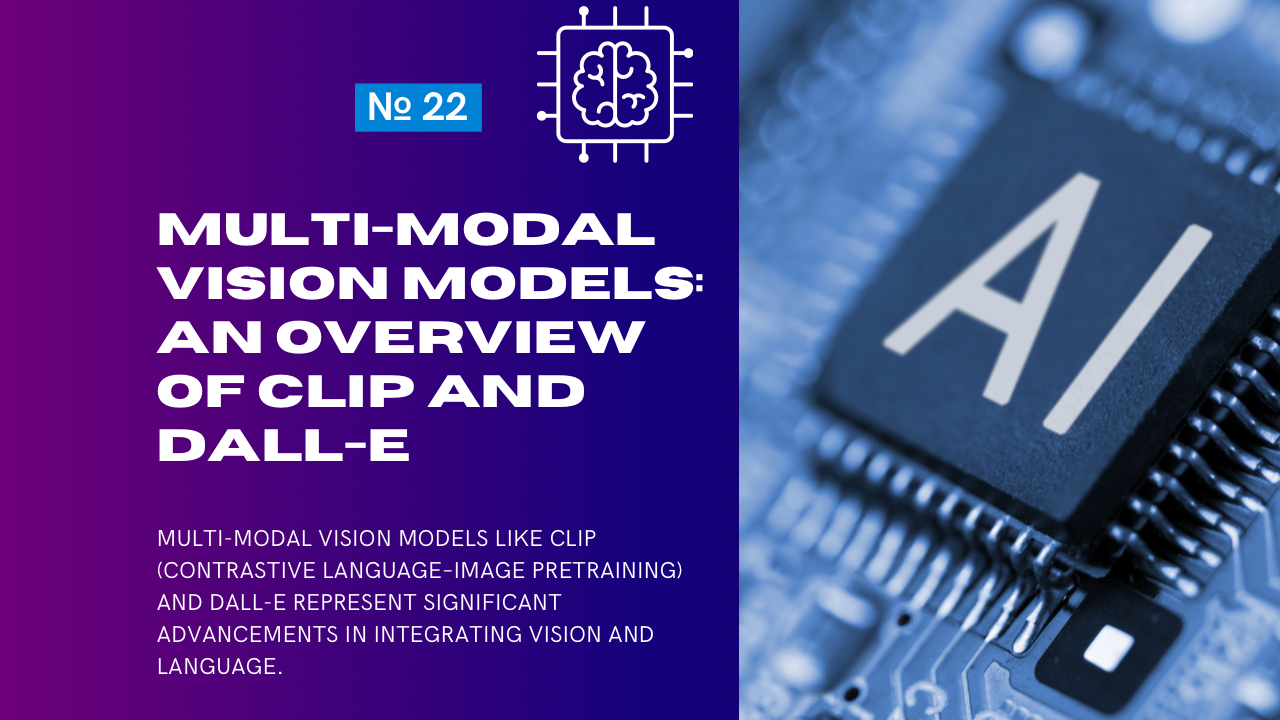Multi-modal vision models like CLIP (Contrastive Language–Image Pretraining) and DALL-E represent significant advancements in integrating vision and language. These models enable new capabilities such as understanding the relationship between text and images, generating realistic images from textual descriptions, and cross-modal reasoning.
1. What are Multi-Modal Models?
Multi-modal models are designed to process and integrate data from multiple modalities, such as:
- Vision (images, videos).
- Language (text, captions, descriptions).
These models leverage the synergy between modalities to enable tasks like:
- Image-text alignment (e.g., “find the image that matches this caption”).
- Text-to-image generation (e.g., “generate an image of a futuristic city at sunset”).
- Image captioning (e.g., “describe the content of this image”).
2. Overview of CLIP
What is CLIP?
CLIP (Contrastive Language–Image Pretraining) is a multi-modal model developed by OpenAI that learns to connect images and text by training on large-scale datasets of image-text pairs.
Key Features:
- Contrastive Learning:
- CLIP is trained to match images with their corresponding captions and distinguish them from unrelated text-image pairs.
- Generalization:
- Performs zero-shot learning, enabling it to classify images without task-specific fine-tuning.
- Multi-Modal Embedding:
- Embeds images and text into a shared latent space, allowing cross-modal comparisons.
Training Process:
- Dataset:
- Trained on 400 million image-text pairs collected from the internet.
- Objective:
- Align image embeddings and text embeddings in a shared latent space using a contrastive loss.
Applications:
- Zero-Shot Image Classification:
- Classify images based on descriptive text without needing labeled training data for the specific task.
- Image Retrieval:
- Search for images using textual queries.
- Content Moderation:
- Identify inappropriate content in images by pairing them with specific text descriptions.
CLIP Architecture:
- Image Encoder:
- Vision Transformer (ViT) or ResNet to process images.
- Text Encoder:
- Transformer-based model (similar to GPT) for text processing.
- Shared Latent Space:
- Both encoders project inputs into a common embedding space, enabling similarity calculations.
Example: Using CLIP
CLIP can be used for zero-shot classification:
import torch
import clip
from PIL import Image
# Load the model and preprocess
model, preprocess = clip.load("ViT-B/32", device="cpu")
# Load and preprocess the image
image = preprocess(Image.open("cat.jpg")).unsqueeze(0)
# Define text prompts
text = clip.tokenize(["a photo of a cat", "a photo of a dog"])
# Forward pass
with torch.no_grad():
image_features = model.encode_image(image)
text_features = model.encode_text(text)
# Compute similarity
logits = (image_features @ text_features.T).softmax(dim=-1)
print("Probabilities:", logits)3. Overview of DALL-E
What is DALL-E?
DALL-E is a generative model developed by OpenAI that creates images from textual descriptions. It represents a breakthrough in text-to-image generation, producing highly realistic and creative images.
Key Features:
- Text-to-Image Generation:
- Generates high-resolution, creative images based on detailed textual input.
- Zero-Shot Capabilities:
- Handles a wide range of prompts, from realistic to abstract concepts.
- Image Variations:
- Generates multiple variations of an image based on the same or modified prompt.
Training Process:
- Dataset:
- Trained on large-scale datasets of image-text pairs.
- Objective:
- Learn to map textual descriptions to pixel-level image generation.
Applications:
- Design and Creativity:
- Generate artwork, illustrations, and product mockups.
- Marketing:
- Create custom visuals for advertising campaigns.
- Education:
- Generate visual content for e-learning and interactive media.
DALL-E Architecture:
- Transformer-based Model:
- Uses autoregressive transformers to predict pixel data conditioned on textual input.
- Image Encoding:
- Encodes images as sequences of discrete tokens.
- Text Encoding:
- Text descriptions are tokenized and encoded to guide the image generation process.
Example: Using DALL-E
Example with OpenAI’s DALL-E API:
import openai
# Set API key
openai.api_key = "your-api-key"
# Generate an image
response = openai.Image.create(
prompt="a futuristic city at sunset with flying cars",
n=1,
size="512x512"
)
# Get the generated image URL
image_url = response['data'][0]['url']
print(f"Generated Image URL: {image_url}")4. Comparison of CLIP and DALL-E
| Aspect | CLIP | DALL-E |
|---|---|---|
| Objective | Learn image-text alignment for retrieval and classification. | Generate images from text descriptions. |
| Primary Task | Zero-shot classification, image retrieval. | Text-to-image generation. |
| Architecture | Contrastive learning with two encoders (image and text). | Transformer-based image generation. |
| Input | Image-text pairs. | Text descriptions. |
| Output | Similarity scores, image labels. | Generated images. |
| Applications | Content moderation, image search, classification. | Creative design, artwork, custom visuals. |
5. Multi-Modal Vision Model Use Cases
| Use Case | CLIP | DALL-E |
|---|---|---|
| Image Search | Retrieve images from textual queries. | Not applicable. |
| Content Moderation | Detect inappropriate content in images. | Not applicable. |
| Text-to-Image Generation | Not applicable. | Generate high-quality images from descriptions. |
| Custom Classification | Classify images using custom textual labels. | Not applicable. |
| Creative Design | Not applicable. | Generate artwork, mockups, and visuals. |
6. Challenges in Multi-Modal Models
| Challenge | Description |
|---|---|
| Data Quality | Requires large, high-quality datasets of image-text pairs. |
| Biases | Models may inherit biases from training data, affecting fairness and representation. |
| Computational Resources | Training multi-modal models requires significant compute power (e.g., GPUs, TPUs). |
| Interpretability | Understanding the reasoning behind model predictions can be challenging. |
7. Future Directions
- Better Cross-Modal Understanding:
- Develop models that combine image, text, and audio for richer multi-modal reasoning.
- Ethical AI:
- Address biases in datasets to improve fairness.
- Efficiency:
- Optimize models for lower resource usage and faster inference.
- Real-Time Applications:
- Apply multi-modal models to AR/VR, robotics, and real-time systems.
Conclusion
- CLIP excels in tasks that require understanding the relationship between text and images, making it ideal for image retrieval and zero-shot classification.
- DALL-E pushes the boundaries of creativity with text-to-image generation, enabling applications in design, marketing, and education.
